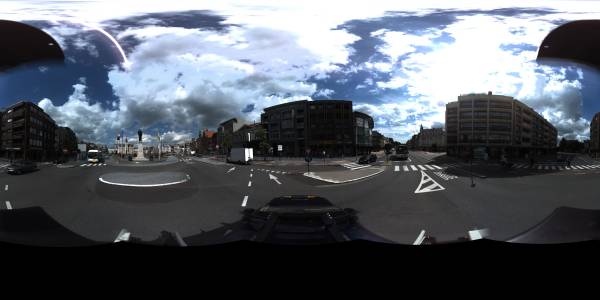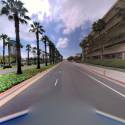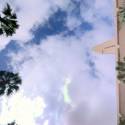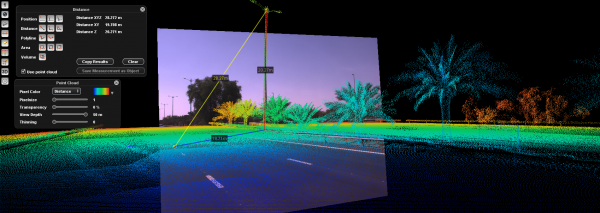For documentation on the current version, please check Knowledge Base.
Supported Resources for Mobile Mapping
This page describes the supported Mobile Mapping resources, any combination of the listed resources can be used.
Special Notes
Two important notes before diving into the details :
Import Template
Orbit imports mobile mapping data using intelligent templates. An import template is configured according a given vehicle setup and available data.
The use of templates simplifies and standardizes the import procedure for a well known set of data.
Generic Import
The default website download includes some generic import templates.
The specifications and data structure can be viewed here : Prepare MM data Generic Import.
Download Templates
More system and custom custom import templates can be downloaded here : Data Preparation and Import Templates.
Customize Import
In addition on the available templates the Orbit engine offers all configuration possibilities to customize and optimize the import for using any kind or combination of mobile mapping data. Once the configuration is known, it can be added as new import template to extremely simplify all future imports.
Please contact the Orbit support team (support at orbitgt dot com) for more information or to create your customized template.
Coordinate Reference Systems
Orbit supports any combination of oblique data and any coordinate system on import. But be wise :
- The coordinate reference system should be part of the metadata of each resource.
- It is advised that all georeferenced resources are using the same CRS to avoid processing time of continuous coordinate transformation. If required convert CRS on import run.
- When converting the coordinate system of image positions apply the according adjustments on all orientation angles referring the reference direction of the coordinate systems (most probably north).
Index
Imagery
Orbit supports spherical images (panoramas) and planars.
There are no limitations on the number of cameras, the type of camera or the resolution of images.
One camera import requires one set of images and one positions and orientations file.
Imagery is optional for Orbit MM Desktop products. The Orbit MM Publisher requires the availability of spherical images (panoramas) to operate and does not support planar images.
Image positions and orientations
The absolute position and orientations at time of recording of all images must be available unambiguously.
Two possibilities :
- absolute position and orientation for each camera at time of recording
- combining the absolute position and orientation of a reference frame at time of recording with the fixed relative position and orientation for each camera to this reference frame (aka lever arm corrections).
Absolute positions and orientations at time of recording
Supported formats
Preferably .txt or .csv resource.
But any supported point vector resource can be used.
Specifications
- One text file for each camera containing at least the below described information for each image.
- Column names are optional and free of choice.
- Columns and order of columns can be customized.
- Positional information can be expressed using any supported coordinate system. If required coordinates can be re-projected or transformed on import.
- Orientations can be expressed as :
- Pan (heading, yaw), Tilt (pitch), Roll 1)
Reference direction and orientation are documented below, but can be customized. - Omega, Phi, Kappa 2).
Reference direction is pointing eastwards, but can be customized. - Normalized direction and up vector (direction Easting, direction Northing, direction Elevation, up Easting, up Northing, up Elevation)
- Origin (rotation = 0°) or rotation offset and positive sense of rotation of orientation angles can be customized.
| Field | Description | Data type | Units | Necessity |
|---|---|---|---|---|
| Filename | Image file name as is on disk or any reference to the image file. | string | required | |
| Timestamp | Time at recording. Preferable GPS Time but any date-time notation can be used. It is required to use the same notation for all imported mobile mapping resources. If GPS time notation 3) has been used, Orbit will display this as yyyy-mm-dd hh:mm:ss on the image. | string integer decimal | optional | |
| X | X, Longitude or Easting of reference point | decimal | degrees meters | required |
| Y | Y, Latitude or Northing of reference point | |||
| Z | Z or Height of reference point |
| Pan | Horizontal angle between reference frame and north. Positive for clockwise rotation of reference frame. Value 0 looking north, value 90 looking east. | decimal | degrees radians grad | required |
| Tilt | Vertical angle or inclination about the lateral axes between reference frame and horizontal plane. Positive when reference frame goes up / looking up. Value 0 looking horizontally, value 90 looking vertically at the sky, value -90 looking down. |
|||
| Roll | Vertical angle or inclination about the longitudinal axes between reference frame and the horizontal plane. Positive when reference frame rolls to the left, right hand turn. |
| Omega | Rotation of the reference frame about X. | decimal | degrees radians grad | |
| Phi | Rotation of the reference frame about Y | |||
| Kappa | Rotation of the reference frame about Z |
| Direction_Easting | Unit vector defining heading and pitch. By definition value range between 0-1. | decimal | undefined | |
| Direction_Northing | ||||
| Direction_elevation | ||||
| Up_Easting | Unit vector defining roll. By definition value range between 0-1. |
|||
| Up_Northing | ||||
| Up_elevation |
Relative position and orientation
Only when using an absolute position and orientation of a reference frame at time of recording, the fixed relative position and orientations for each camera to the used reference frame must be given.
If the absolute position and orientations of the images at time of recording are known, these relative positions and orientations can be ignored.
| Field | Description | Data type | Units | Necessity |
|---|---|---|---|---|
| CameraName | Unique name to identify the camera and to link these camera specification with the position and orientation file. | string | optional | |
| CameraDeltaX | Fix distance in X expressed in meters from the origin of the camera reference frame to the IMU/GPS reference frame. | decimal | meters | required |
| CameraDeltaY | Fix distance in Y expressed in meters from the origin of the camera reference frame to the IMU/GPS reference frame. |
|||
| CameraDeltaZ | Fix distance in Z expressed in meters from the origin of the camera reference frame to the IMU/GPS reference frame. |
| CameraDeltaPan | Fix Pan of camera reference frame to IMU/GPS reference frame. Positive for clockwise rotation of camera frame. | decimal | degrees radians grad | required |
| CameraDeltaTilt | Fix tilt of camera reference frame to IMU/GPS reference frame. Positive when camera frame goes up / looking up. |
|||
| CameraDeltaRoll | Fix roll of camera reference frame to IMU/GPS reference frame. Positive when camera reference frame rolls to the left. |
| CameraDeltaOmega | Fix Omega of camera reference frame to IMU/GPS reference frame. | decimal | degrees radians grad | |
| CameraDeltaPhi | Fix Phi of camera reference frame to IMU/GPS reference frame. | |||
| CameraDeltaKappa | Fix Kappa of camera reference frame to IMU/GPS reference frame. |
Origin (rotation = 0°) or rotation offset and positive sense of rotation of orientation angles can be customized.
Panoramas
Panoramas (spherical or 360° images) are optional for Orbit MM Desktop products. The Orbit MM Publisher requires the availability of spherical images (panoramas) to operate.
Supported formats
Preferably .jpg files.
But any supported image resource can be used.
Supported types
Orbit supports any Spherical and Cubic Panorama, independently of file size or pixel resolution.
For example, Ladybug 3 and 5 are supported.
Equirectangular Panoramas

When working with Spherical panoramic images Orbit is using the stitched 360 x 180 degree panoramic image.
- Stitching the images should be done by the camera software, knowing and applying all camera calibration and distortion parameters.
- The centered pixel of the picture will be used to affect the orientation angles. If required this can be re-configured via a customized import.
- Any 2 x 1 pixel resolution ratio can be used but an equirectangular panoramic image should always be 360 x 180 degree.
There are no limitations on the image pixel resolution. If required Orbit can optimize high resolution images (> 8000 x 4000 pixels) for online use.
Cubic Panoramas
Since Orbit AIM version 10.5.1 Cubic Panoramas are supported.






When working with Cubic panoramic images Orbit is using the 6 original equirectangular images.
- To display and use cubic panoramas properly it is required to know all orientation, calibration and distortion parameters from the used camera's.
- Any pixel resolution can be used.
Planars
Planars are optional for Orbit MM Desktop products. The Orbit MM Publisher does not support planar images.
There are no limitations on the number of cameras, the type of camera or the resolution of images. One camera import requires one set of images and one positions and orientations file.
Supported formats
Preferably .jpg files.
But any supported image resource can be used.
Supported types
Orbit supports any distorted Planar picture, independently of file size or pixel resolution.

Camera calibration
For each camera following camera and sensor specifications will be used to optimize the integration and accuracy in Orbit.
| Field | Description | Data type | Units | Necessity |
|---|---|---|---|---|
| CameraName | Unique name to identify the camera and to link these camera specification with the position and orientation file. | string | optional | |
| SensorName | Reference of sensor to have the possibility to review the sensor specifications. | string | optional | |
| SensorPixelSize | Physical size of pixels on the sensor CCD, expressed in mm. | decimal | mm | required |
| SensorPixelCountX | Number of pixels in width of the camera sensor and image. | integer | pixels | required |
| SensorPixelCountY | Number of pixels in height of the camera sensor and image. | |||
| SensorPixelPPX | The principal point value along the sensor width, expressed in number of pixels from left lower corner. Wikipedia Focal Point | decimal | pixels | required |
| SensorPixelPPY | The principal point value along the sensor height. | |||
| FocalLength | The focal length of the lens, expressed in mm. Wikipedia Focal Length | decimal | mm | required |
| k1, k2, k3, p1, p2 | Radial distortion parameters, regarding the formulas of D.C. Brown. Wikipedia Distortion | decimal | optional |
Image Metadata
Metadata is optional, there is no limitation on the number of added image meta-attributes on import.
- date
- timestamp
- date time
- accuracy
- GPS information
- photo group id
- …
Point Cloud
Point clouds are optional, there are no limitations on the number of imported point cloud files nor their size.
The point cloud data can be expressed in any coordinate system.
While importing Orbit can apply a coordinate transformation and/or re-projection between any supported coordinate system.
Supported Formats
Preferably .las (v1.2) files.
But any supported LiDAR resource can be used.
Specifications
- Files : one or multiple supported LiDAR resources
- Positional information can be expressed using any supported coordinate system. If required coordinates can be re-projected or transformed on import.
- Data-structure : default structures
Data-structure when using Ascii text files
When using an Ascii text file as point cloud import it is possible to configure the data-structure :
- Flat ascii text file, separated, columns and column headers
- R, G, B, I value ranges 0-25, values may be empty
- Character to define end of line
Trajectory of Vehicle
A trajectory is optional and can be used to display the accuracy or to adjust, clip or extract a segment of the entire mobile mapping run.
Prepare the trajectory file in the same way as the image position and orientation file : see above.
| Field | Description | Data type | Units | Necessity |
|---|---|---|---|---|
| Timestamp | Time at recording. Preferable GPS Time but any date-time notation can be used. It is required to use the same notation for all imported mobile mapping resources. | integer decimal string | optional | |
| X | X, Longitude or Easting of reference point | decimal | degrees meters | required |
| Y | Y, Latitude or Northing of reference point | |||
| Z | Z or Height of reference point | |||
| Accuracy | Any indication of accuracy (mean-square error, gps accuracy, … ) at time of recording. | decimal | optional |
Leap seconds are not taken into account.
More information : Wikipedia, GPS Timekeeping and Wikipedia, Leap seconds.
